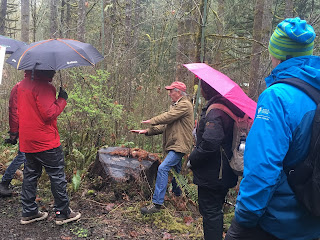Date of Visit: April 18, 2019
Type of event: Study tour
Topic: Urban Forestry
Organization: Portland Parks & Recreation
Location: Forest Park, Portland, Oregon
Hosts: Marshall Johnson / Forest Park Natural Resource Ecologist, Becca Shively / Renew Forest Park Program Specialist
International Fellows: Richard Banda (Malawi), Fen-hui Chen (Taiwan), Temitope Dauda (Nigeria), Zhongyuan Ding (China), Ana Kanoppa (Brazil), Will Maiden (United Kingdom), Romain Matile (France), Rodolfo Vieto (Costa Rica)
WFI Staff: Shadia Duery / International Fellowship Program Manager
The International Fellows’ most recent study tour was a visit to Portland’s Forest Park, a 5,100-acre expanse of urban forest on the outskirts of Portland. Forest Park is one of the largest urban forests in the US, so what better place to look at the issues presented in managing urban trees? The site is currently predominantly second-growth Douglas fir and bigleaf maple, as timber production only ceased in 1948 following the park’s creation. The park is funded at a city level but also raises additional capital by bidding for government grants. Managers work in close cooperation with the Forest Park Conservancy Trust, a partnership which allows a greater amount of habitat restoration to take place. The Fellows were met by Marshall Johnson from the Portland Parks & Recreation Department, who led them on an insightful hike to explain the management of the site and show areas where habitat conservation work is occurring. Marshall explained that the site is chiefly managed for ecology, aiming to restore the site to a more natural condition. This is being achieved through the 20-year Renew Forest Park initiative, which aims to restore habitat, rebuild infrastructure, and reconnect local stakeholders through improved access.
 |
| Marshall from Portland Parks & Recreation explaining site management to the International Fellows |
| Much of the habitat restoration work in Forest Park is carried out by volunteer groups |
Of chief concern is the effort to control the spread of invasive, shade-tolerant species, such as English ivy (Hedera helix) and holly (Ilex aquifolium). These are garden escapees and outcompete the natural vegetation, resulting in lower levels of biodiversity within the urban forest. Herbicide application has been chosen as the most practical form of management, and large areas of treated vegetation were visible within the forest. Portland Parks & Recreation has worked to inform and educate park users by providing interpretation boards and distributing leaflets to local residents.
A key aim in the park’s management is not to exceed carrying capacity of the site. Portland’s population is continuing to grow, meaning park use is predicted to increase. Portland Parks & Recreation are exploring options to increase revenue generation and increase education to prevent damage occurring to the forest ecology. This is no easy task considering the multiple access points and size of Forest Park.
An International Fellow’s Thoughts and Perspectives
| Will Maiden, International Fellow from the United Kingdom |
The location of Forest Park next to a large urban population reflects much of my work back in my home country, the United Kingdom. It was interesting to hear how a municipal agency works in partnership with conservation agencies to achieve ecological aims. This is an area where I see potential lessons to take back to the UK, where government funding cuts are resulting in cuts to the management of parks and green spaces.
Seeing British native species acting as invasive weeds was interesting. Holly and ivy provide beneficial additions to the British environment. However, when moved into a new habitat, these non-native species outcompete native flora and have a detrimental effect on biodiversity. As my research in the US focuses on the management of pests and disease, it was good to hear that a robust monitoring and eradication of pest species is in place in Forest Park. This has resulted in the successful eradication of a Gypsy Moth outbreak within the forest. The UK would benefit from Oregon’s approach regarding pest monitoring and raising awareness of the issues that pests and disease pose to the forest ecosystem.


